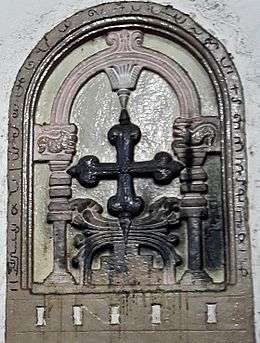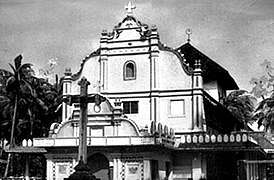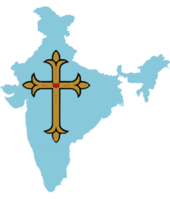Mar Sabor and Mar Proth Church, Akaparambu
Mar Sabor & Mar Afroth church Akaparambu is one of the ancient churches in Kerala. In ancient records the church is referred to as the Akaparambu Valiyapally.[1][2]
| Mar Sabor Mar Afroth Church Akaparambu | |
|---|---|
 Mar Sabor Mar Afroth Church Akaparambu | |
| Religion | |
| Affiliation | Malankara Jacobite Syrian Church |
| District | Ernakulam |
| Province | Kerala |
| Location | |
| Location | |
| Architecture | |
| Type | Church |
| Style | Kerala Architecture |
| Completed | 825 CE |
| Direction of façade | West |
History
The church is famous for the beautiful ancient mural paintings.[3] The Bishop Mar Gregorios Vayaliparambil (1899–1966) belonged to this parish church. For long time the church at Ankamaly and the Mor Sabor and Mor Afroth chapel at Akaparambu were a united parish and was administered by one council.[4]
Mar Sabor & Mar Afroth

Mar Sabor and Mar Afroth were two holy men who came to Malabar to preach the Gospel with a group of Assyrian Christian(Nestorians ) immigrants led by a merchant named Sapor Esho. They were said to have landed at Quilon (Kollam) in circa 822. There is no documentary evidence in church records and government archives that Mar Sabor, Mar Afroth and Sapor Esho brought a group of Syrian Christian immigrants.The Chera king of that period thought they were merchants because merchants from abroad frequently came to Kerala — Greeks, Romans, Arabs, Persians and Jews.
The Chera ruler assuming Sapor Isho was a merchant gave him copper plates with privileges and a village inhabited by lower castes, as it was the custom in those days to entertain foreign merchants.
Mar Sapor later known as Mar Abo. His tomb is at Thevalakkara St St Marys orthodox Valiyapally. Mar Afroth Tomb at Chayal Church, Nilackal (The church founded by St. Thomas.Sapot Isho who came alone to Kollam settled in the village given by the Rajah, and as a missionary, converted the people of the village given to him. This converted local community was the nucleus which grew into a major Syrian Christian community in Kerala. They were brought up by Sapor Eso in the tradition of St. Thomas faith.
When the Portuguese came to Kerala, they found that these bishops using Syriac liturgy and therefore they called them Syriac Christians to distinguish them from Latin Christians converted by the Portuguese who were using Latin liturgy. Mar Sapor elevated a local convert to the position of catechist (kathanar) and he became famous as a Kadamuttathu Kathanarr.
According to legends, he maintained contact with his former tribal leaders and through them he learnt magical and mystical powers. Mar Sapor is remembered for converting the entire village of lower castes given to him by the Rajah and this led to the growth in numerical numbers of local converts who later called themselves Syrian Christians because of the Syriac liturgy introduced by Mar Sapor . The church at Akaparambu is believed to have been established in A.D. 825. [5]
Gallery
 Persian cross at Kadamattom church
Persian cross at Kadamattom church
References
- "Akaparambu S.o.A." www.syrianorthodoxarchdiocese.com.
- "Mor Sabor Mor Afroth Jacobite Syrian church, Akaparambu". www.syriacchristianity.info.
- "Murals- Akaparambu Church, Arts, Kerala, India Video". indiavideo.org. Retrieved 6 August 2016.
- Pynadathu, Bibu Mathew Vayaliparambil. "Morth Mariam Church, Angamaly". cua.edu. Retrieved 6 August 2016.
- Kaniamparambil, Cor Episcopos V. Rev. Curian (1991). "The Fame of Angamali Church and Holiness of Mor Kurilos". Ambattu Mor Kurilos Centenary Souvenir. Ankamaly, India: St. Mary's Jacobite Syrian Church.
